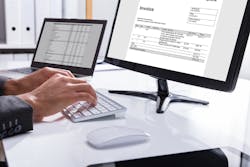Automated accounts receivable tracks customers at credit risk
One of the first steps in taking on a new customer is to assess their creditworthiness. Such evaluation typically entails reviewing some kind of credit report that shows the company’s payment history, revenue and outstanding obligations. If you are satisfied with what you learn from the report, you can proceed with doing business with that customer.
In an ideal world, there would be no reason to spend any more time analyzing the credit risk of that customer. But the business environment is constantly changing, and those changes can sometimes negatively affect your customers’ ability to pay, and, thus, their credit rating, often after you’ve conducted your due diligence.
Unless you have automated your accounts receivable function, you might not spot a problem until it is too late. A manual AR system may not notice a shift in how incoming payments are timed. It is important to remember that a slight change in payments — whether in the amount submitted, or the regularity of payments, or the date that payments historically come in — can, at some point, devolve into a problem customer.
By automating your accounts receivables, you can reduce credit risk among your existing customer base through:
- Real-time visibility into payment patterns
- Real-time analytics of available data
- Having someone who can perform a reliable credit risk assessment
An automated system provides that crucial visibility into payment patterns and allows you to overlay payment data with real-time analytics. Using dashboards that are part of the automated process will allow you to see even small discrepancies in payment patterns. This allows you to take action sooner, before the little problem morphs into a customer that can’t pay.
Once you discover that a customer has deviated from his normal payment schedule, you can call him and tell him that you have noticed a small change in payment pattern. You can then ask if there was a problem with the invoice or the work you did or if something is going on internally that has resulted in the slower payment.
You could find out that it was simply an oversight or a seasonal blip and you can resume having business as usual with that customer. If the answer is troubling, at least you know early on and can alter credit terms to prevent any significant impact to your bottom line.
An automated billing solution will provide you with up-to-the-minute information that allows you to see tiny shifts in payment activity and act quickly to reduce any possible risk to your business.
About the Author
Matt Clark
Matt Clark is the president and CEO of Corcentric, a procurement and finance company that helps companies reduce expenses and improve working capital by optimizing how they purchase, pay, and get paid.
